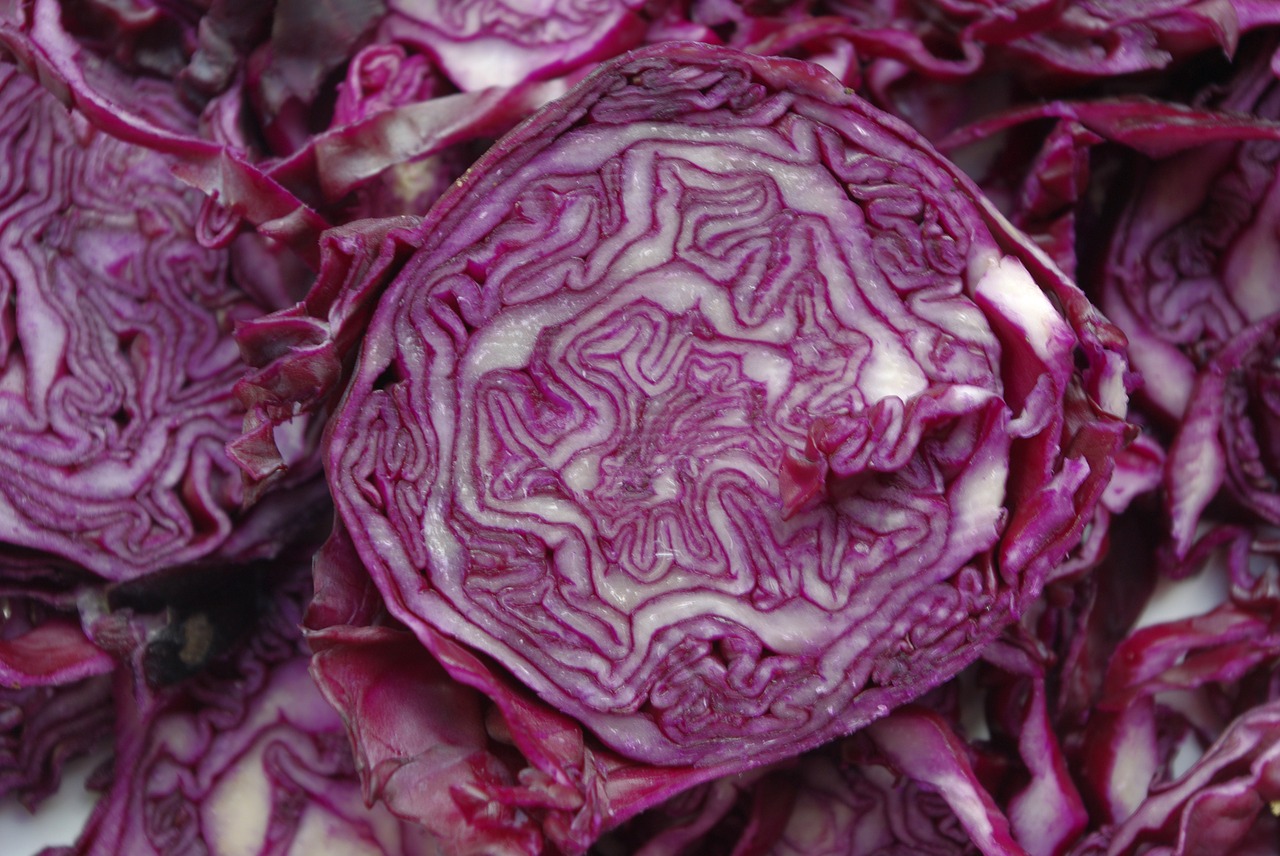As with zucchini and yellow squash, for this Difference Between post we’re looking not at the obvious distinction between the two (color), but instead are focusing on nutrition and flavor.
Let’s start with the flavor first, as that is much more simpler than the nutritional content: In short, they taste the same, meaning that you can substitute one for another in recipes. Although, FoodSubs.com points out that if substituting red for green, “this can discolor other foods if combined [in] a salad or cooked with them, but it tastes just like green cabbage.”
When it comes to taste differences, Savoy cabbage, despite it’s rough looking exterior, is actually more delicate and mild flavored than its more well known counterparts. Furthermore, Napa cabbage is even milder still, according to my Vegetables Revised cookbook (which just happens to have Savoy cabbage on the cover).
Below is an image of Savoy cabbage – you can see how the leaves are a lot rougher looking.
So, green and red cabbage taste essentially the same, you might just want to pick one over the other for presentation purposes. Let us now move on to the nutritional differences.
Thank you to the following websites for their information: WHFoods.com (here and here), HealthyEating.SF.Gate.com, LiveStrong.com, and GreenParenthood.com.
By the way, WHFoods.com is truly the best source on the internet as far as nutritional content of vegetables goes; I also own their book.
In short, red cabbage is healthier than green, but green does win in one category.
Red cabbage over green cabbage:
- More anthocyanins
- Double the amount of iron
- More potassium
- 10 times more Vitamin A
- More Vitamin C
Green cabbage over red cabbage:
- More Vitamin K
If you want to get more specific, one cup of shredded red cabbage contains 170 miligrams of potassium with green at 114 miligrams. One cup of chopped red cabbage has 51 miligrams of Vitamin C, compared to 37 miligrams of chopped green cabbage – although, it can sometimes contain up to 50% more Vitamin C than green. And, green cabbage consists of 57% of the recommended daily intake of Vitamin K, with red cabbage at 28%.
The anthocyanins in red cabbage come from its beautiful, vibrant color – they act as antioxidants, supporting the immune system among other good things.
Although red does beat out green nutritionally, you really can’t go wrong with either cabbage you choose – they’re both low in calories and high in healthful properties (so is true of Savoy and Napa cabbages).
Unfortunately, long cooked cabbage does lose some nutrients in the cooking process. If you can, try eating raw cabbage! Savoy cabbage in particular works well in salads.

Comments
18 responses to “Difference between: green cabbage and red cabbage”
Speaking of difference between–the recipe called for scallions and the supermarket didn’t have any so I got green onions–how’s that going to work out?
Should work out just fine!
you wont even know the difference
[…] green and red cabbage are identical, but according to this site, red cabbage is significantly more nutritious. That’s a great reason to use it. That and the […]
I think that green cabbage is easier to cook (cooks in less time) and it tastes milder. Red cabbage CAN be tough.
When I was in the army during the Korean war I got an stomach ulcer which I cured with green cabbage juice ! That stuff is truly remarkable. Will red cabbage do the same ? Does it have the same curative properties? Thanks
Wow, that’s good to know!
I briefly researched stomach ulcer curing properties in green versus red cabbage – it looks like green cabbage is preferred and may be slightly more effective. There is more of an emphasis on making the cabbage juice from fresh cabbages, though.
It was probably the vitamin K which is superior in the green cabbage. Lookup vitamin K (not Ketamine, which has a street name of Vitamin K).
Yes not Ketamine, important distinction! 😛
Another good thing about red cabbage is that if you are adverse to artificial dyes, you can boil it down and be left with purple coloring, let it cool down completely, add a half tsp of baking soda at a time to make a blue color. Perfect solution to anything that calls for these colors … naturally!
Beets are also used as a source of natural food coloring.
So cool. Thanks for sharing that
Makes for pretty hard-boiled eggs. Also fermented cabbages take both up a notch. I could about live on Cortido (Latin American kraut).
no remarks first time viewing
It’s Better To Take Light Cooked Cabs Over Raw Cabs Due To The Risk Of Cabbage Worm(causes Cerebral Cysticercosis).Thxs
Which is why i treat my red cabbage with dioxin…..
The Cabbage WORM?!?! Omg!!
I have experienced the cabbage worm. So now I soak a head of cabbage or lettuce (fresh or store bought) in the kitchen sink much like you should with fresh cherries. Worms float to the top and then I put the head of cabbage/lettuce in the dish strainer for a while (heart/root up) and then into the crisper drawer in the fridge.